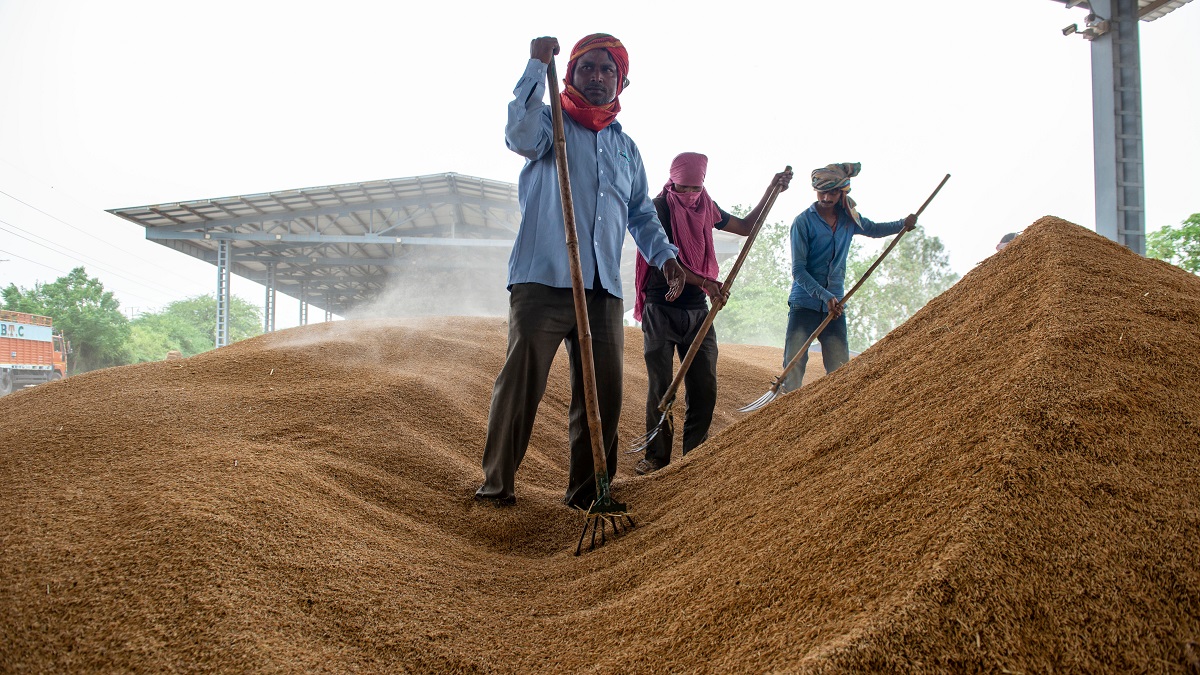Commodity importers are hit hardest while fossil fuel exporters register temporary windfall gains.

© PradeepGaurs/Shutterstock | Workers at a grain wholesale market in the Narela district, New Delhi, India.
The world economy is expected to grow 2.5% in 2022, according to UNCTAD’s Trade and Development Report 2022.
This is more than one percentage point below the rate projected in last year’s report and prospects appear to be worsening, with growth expected to decelerate further next year to 2.2%, leaving real GDP below its pre-Covid trend by the end of 2023.
The report worries that an unduly rapid tightening of monetary policy in advanced economies in combination with inadequate multilateral support could turn a slowdown in to recession, triggering vicious economic circles in the developing world with the damage more lasting than after the global financial crisis or Covid shock.
South Asia
The global slowdown is ringing alarm bells across the developing world. For South Asia, UNCTAD expects a weakening economic expansion of 4.9% in 2022, as inflation increases on the back of high energy and food prices, exacerbating balance of payment constraints and forcing several governments to restrict energy consumption.
Moreover, the combination of elevated prices for imported commodities, depreciating local currencies and tightening global financial conditions have only intensified already acute levels of debt distress faced by a number of countries. For 2023, UNCTAD expects the region’s growth rate to decelerate further to 4.1%.
This year’s sell-off in emerging market dollar-denominated bonds is exacerbating debt distress across several economies of South and Western Asia.
Besides Sri Lanka, Lebanon has also fallen into sovereign default, Afghanistan remains in debt distress, and Türkiye as well as Pakistan currently face bond yields close to or above 10 percentage points relative to United States 10-year treasury bills.
Pakistan was expected to slow down this year after the strong bounce last year (close to 6% growth) from the Covid-linked contraction in 2020.
But its mounting debt burden and falling foreign reserves had already pushed the country into negotiations with the International Monetary Fund even before the situation turned critical as devastating floods killed thousands of people, ruined crops and destroyed infrastructure around the country.
This illustrates the vicious circle of climate disaster and austerity into which vulnerable developing countries risk falling as global warming accelerates amid insufficient international climate support for countries whose per capita CO2 emissions remain a fraction of advanced countries.
In India, the largest economy of the region, economic activity is being hampered by higher financing costs and weaker public expenditures, resulting in a deceleration in GDP growth to 5.7% in 2022.
Going forward, the government has announced plans to increase capital expenditure, especially in the rail and road sector, but in a weakening global economy, policymakers will be under pressure to reduce fiscal imbalances, and this may lead to falling expenditures elsewhere.
Under these conditions, economic growth is expected to drop by one percentage point to 4.7% in 2023.
Western Asia
In Western Asia GDP growth is expected to decelerate to 4.1 % in 2022, with sharpening contrast between fossil energy-importing and -exporting countries, owing to high commodity prices.
In the former, the higher import bill for both fuel and food products is putting a significant strain on the economy, and the situation is aggravated by the tightening of international financing conditions. As a result, households are being squeezed, particularly by food prices, with very limited state support.
Meanwhile, in energy exporters, higher fiscal revenues from higher prices and boosted by significant increases in oil production volumes in line with the OPEC+ agreement’s gradual relaxing of output restrictions, has provided governments the room to extend relief to households from inflationary pressures.
The report does not expect these windfall gains to last for long as growth is projected to decelerate to 2.9% in 2023, depressed by weakening external demand.
UNCTAD estimates growth in Saudi Arabia will reach 6.6% in 2022, before declining to 3.9% in 2023.
The above-average performance driven by increased oil export earnings will continue to help finance the government’s ambitious public investment plans, particularly for large-scale infrastructure projects.
Yet, continued tightening of monetary policy in 2023 to respond to United States policy will prove a drag on growth.
Türkiye’s economic expansion has already decelerated abruptly to 2.4% in 2022 and will remain at that level in 2023. Weakening global demand and higher prices for imported commodities will cause a deterioration in the current account deficit; meanwhile, inflation topped 70% by mid-2022, and this will dampen consumption growth.
The sharp depreciation of the lira has added further upward pressure on prices and increased the costs of servicing the country’s considerable foreign-currency denominated debt.



